TODAY'S FARM ANIMALS
THE INSIDE STORY
Page f
MEAT TYPE CHICKENS - OFTEN CALLED
BROILERS
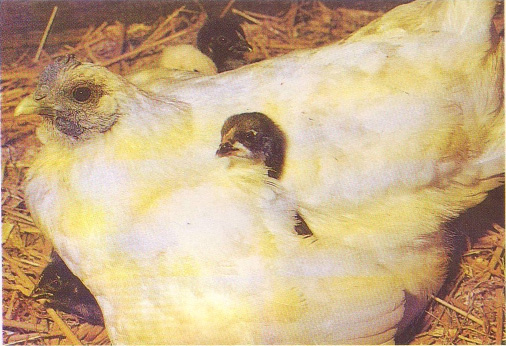 Under natural conditions the mother hen is fiercely protective of her chicks, sheltering them under her wings for their first two months of life. Genetically selected for fast growth, broiler chickens are slaughtered when only 6 or 7 weeks old (a healthy chicken's lifespan is as many years) and never experience maternal care. Photo: David Clegg
Under natural conditions the mother hen is fiercely protective of her chicks, sheltering them under her wings for their first two months of life. Genetically selected for fast growth, broiler chickens are slaughtered when only 6 or 7 weeks old (a healthy chicken's lifespan is as many years) and never experience maternal care. Photo: David Clegg
A cruel mess - this is how Professor John Webster of Bristol University has described the broiler industry. FAWN invites you to take a close look at how today's
A Short Life and a Brutal One
Mass-produced chickens (around 99% of the market) spend their short lives in huge windowless sheds. Motherless, the chicks must fend for themselves from day one. Those that fail to find their way to food and water points are called 'starve-outs'. Towards the end of the cycle, some broilers are so crippled they cannot walk, so these too die from starvation and dehydration.
Baby Giants
Selective breeding for 'greedy' birds, and the addition of growth-promoters to the feed, have ensured an end-product twice as heavy at seven weeks as chickens should be - and were, before the poultry and drug industries moved in. The result? PROFITS for producers and SUFFERING for the sick and deformed birds.
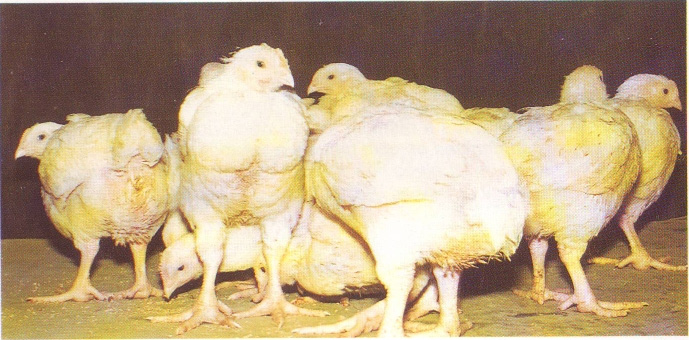
Six week old broiler chickens.
Squalid Conditions
An attempt to collect the 'deads' should be a daily task. A poultry worker has described it as follows:
'This has to be done every day because of the heat and the way the birds are packed so tight. When you pick up a dead bird it's quite common for them to be so putrid that they are just bags of bone and fluid.
(Lincolnshire Free Press, 5 Oct '87)
When birds are reared together in such huge numbers (45,000 in one shed is typical of new units) proper welfare inspections are impossible. Many dead and dying birds go unnoticed, to decompose in the litter on the shed floor. Heat stress is a major cause of death. Botulism has occurred in cattle fed or bedded on used chicken litter.
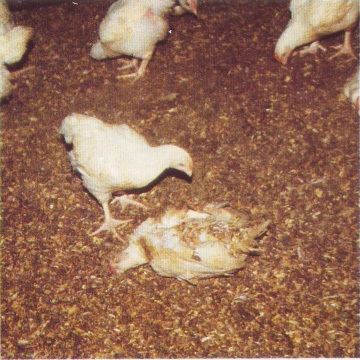 Living birds peck at the dead. Photo: Oxford Environmental Films |
Diseases (including heart attacks and fatty liver and kidney syndromes) kill many young birds. Now, viral diseases like Gumboro (this destroys the immune system - it's been called 'chicken' AIDS') and chicken anaemia agent (CAA) have taken their toll, often pushing mortality figures well into two figures. (Yes, Gumboro has been known to kill 10-20 thousand chickens in one shed alone!) Ascites provides another major headache for an industry which has produced a bird with masses of profitable flesh, but organs so immature they cannot function effectively. Ascites results in an internal accumulation of yellow or blood-stained fluid. It's a disease associated with
'The high oxygen demand of rapid growth in the modern broiler, combined with restricted space for blood flow through the capillaries of the lung'.
(Poultry Diseases, Ed. F T W. Jordan, Baliere Tindall 1990)
Painful Afflictions
Millions of broiler chickens develop painful ulcerated feet and hock burns (these are like bed sores in humans). High ammonia levels can cause blindness. All this suffering occurs while broilers are mere baby birds.
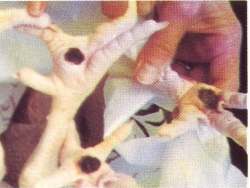 Chickens with ulcerated feet sold for human consumption. Photo: Chickens' Lib |
Catching, transport and slaughter all cause trauma and pain to broilers. Soft young bones break, and joints (often already painfully deformed) become dislocated when birds are caught. Carried several in each hand spent hen slaughter, a 'humane' kill is never guaranteed, and it's been suggested by poultry researchers that many chickens are inadequately stunned, and feel the pain of neck cutting. Again, some enter the scalding tank alive, perhaps conscious.
Future Deprivations?
A disturbing picture is emerging of novel ways of 'papering over the cracks' of the disastrous broiler industry. Feed restriction for the young birds has been recommended as a way of minimising diseases associated with unnaturally rapid growth and poor environmental conditions.
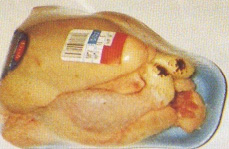 Supermarket chicken showing hock burns. Photo: Chickens' Lib. |
'With controlled feeding of broilers becoming a growing trend it is important to sell it as a welfare friendly management style to the general public. This means getting the right message across which is "controlling growth" not "restricted feed"... there is obvious potential in controlling the growth of broilers, but it needs the right terminology.'
(John Farrant, Editor, Poultry World, November 1994)
In plain English, hungry broilers are getting their exercise foraging in faeces and litter for non-existent feed!
A leading poultry scientist has suggested caging broilers (this already happens in some parts of the world) as a 'solution' to some welfare problems.
The modern broiler is a genetic freak, doomed to all manner of physical and mental ills, all the result of:
. Ruthless selection for heavy birds
. Nutritional programmes and drugs promoting rapid growth
. Environmental factors (poor ventilation, dim lighting, filthy litter,
lack of interesting surroundings to encourage movement).
The poor health status of the modern meat-type chicken is 'man-made' and amounts to cruelty, knowingly inflicted in the name of economics and profit.
Broiler Breeders - the Parent Stock
Hidden well away, and generally forgotten, are the millions of breeders supplying semen and eggs for the chicken meat industry. Kept in broiler sheds in their hundreds or thousands, their lives are stressful, especially for the hens, when frequent coatings result in severe feather wear. Amonia levels in the sheds may be very high, causing blindness.
Many breeding broilers are debeaked, to minimise damage from aggression, and this may cause life-long pain.
Feed Restriction
Feed is severely restricted. Broilers have been specifically bred for 'greediness' as this suits the broiler industry for those birds killed at 6-7 weeks. But if breeders were fed ad lib they'd suffer from disastrously low fertility and high mortality in later life. To 'solve' this problem they are kept on minimal rations that leave them so hungry they peck at empty troughs and the shed walls, eat faeces and litter, and drink large quantities of water in a futile attempt to assuage their appetites. Since excessive drinking produces wet droppings (then soggy litter) the water supply may be restricted too. This regime lasts for their first few months of life. By any normal reckoning, such treatment is cruel and should be prohibited. Even when the degree of feed restriction is less extreme (after week 20) breeders are kept very hungry, to ensure maximum fertility/profitability. The pronounced head shaking sometimes seen among female breeders is probably caused by the stress of constant hunger and unnaturally frequent mating.
Worn-out Breeders Into Canned Soups and Baby Foods
At the end of their peak semen and egg producing days, broiler breeders are slaughtered and processed into pies, soups and baby foods etc. Many are culled during the breeding cycle, since only the most productive birds are kept.
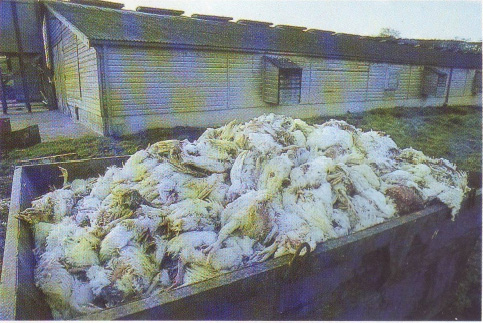
Only a few weeks old - victims of the modern broiler system. Photo: Chris James